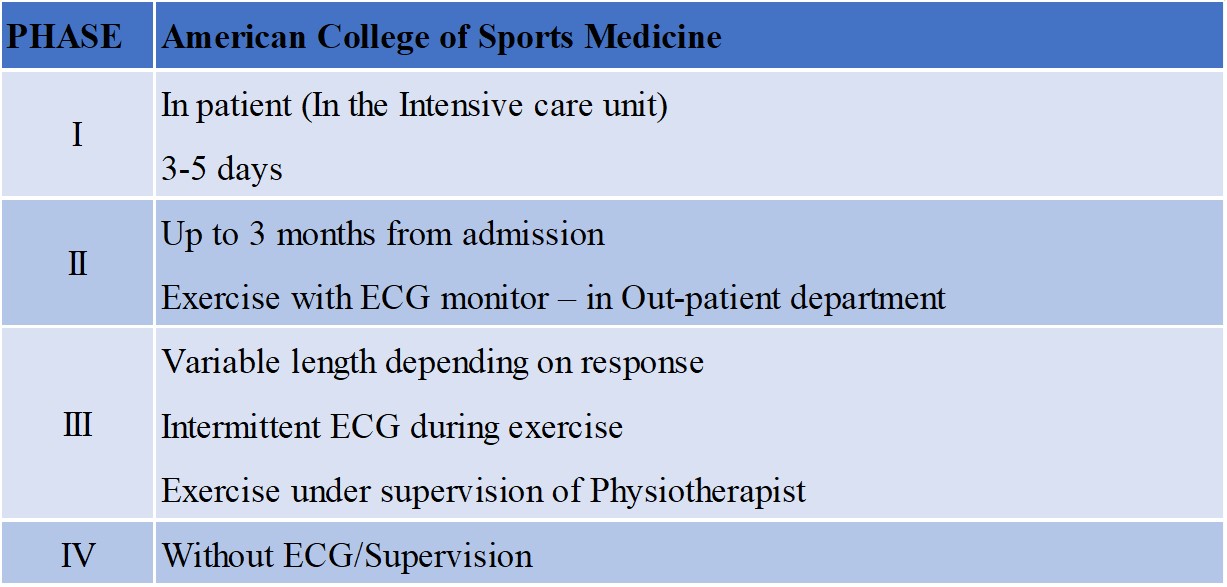
Heart Failure is a life changing condition that is chronic and progressive. Cardiac Rehabilitation is known to be one of the best tools to enhance functioning and well being while improving quality of life. Prof Jaimala Shetye, an experienced Physiotherapist with 39 years of Physiotherapy teaching and clinical experience explains the role of Cardiac rehabilitation in patients with Heart Failure.
What does cardiac rehabilitation mean?
Cardiac Rehabilitation is a coordinated multifaceted intervention (Program) designed to optimize Physical (e.g. Heart rate, respiratory rate, Blood pressure), Psychological (How good a person feels despite the presence of known heart problem) & Social Functioning (Are you able to participate in social activities without any hesitation in-spite of having a known heart or blood vessel problem?) in addition to stabilizing, slowing or even reversing the progression of the underlying atherosclerotic process, thereby reducing morbidity (Disability because of heart problem) & mortality (chance of death because of the heart problem) through improved health behaviours.
Cardiac rehabilitation thus helps to improve the quality of life of a person suffering from known cardiovascular problem.
Cardiac rehabilitation aims to reduce cardiac risk by:
- Weight Management
- Blood pressure Management
- Lipid Control
- Diabetes Control
- Smoking Cessation
- Encouraging Physical activity (Exercise and active life style)
Mr. Sunil is an executive (50 years of age) in a multinational bank and was diagnosed with coronary artery blockages (triple vessel disease) for which he underwent coronary artery bypass surgery. His wife was very cooperative and committed to his recovery. We found that she used to assist him in all the activities like eating, dressing etc. to prevent any physical stress. When they came for Cardiac Rehab, both of them were educated about the benefit of him doing activities on his own which would enhance independence and improve his fitness. It helped them both to understand the concept of early mobilisation for early recovery. Mr Sunil is at present working like before, drives himself to office. He continues to do exercises prescribed by his Cardiac physiotherapist. Exercises are adjusted periodically after testing his functional capacity from time to time. He has now gained confidence in maintaining his diet and fitness to prevent any similar cardiac episodes.
Who should participate in Cardiac rehabilitation?
All who have had any of the following:
- Myocardial Infarction (heart attack)
- Revascularization: CABG / PTCA (Bypass or Angioplasty)
- Heart Valve repair/replacement
- Heart transplant
- Stable Chronic heart failure
- Stable angina (stable chest pain)
- Vascular claudication (Pain in the calf muscles on walking making walking difficult)
- Cardiomyopathy (enlargement of heart muscles)
- Pace-maker implantation
How does Cardiac rehab affect health?
- Limits the physiologic and psychological effects of cardiac illness
- Reduce the risk of sudden death or re-infarction
- Helps control cardiac symptoms
- Stabilize or reverse the atherosclerotic process
- Helps Enhance the psychosocial and vocational status of selected patients.
Why should all Heart failure patients go for cardiac rehab?
Every cell in our body needs Oxygen to work which is supplied by the blood pumped by the heart.
HF is a complex clinical syndrome with symptoms and signs that result from any structural or functional impairment of ventricular filling or ejection of blood. (AHA)
Heart failure is a cardiac condition in which the capacity of the heart to pump the blood to various parts of the body decreases.
A person with chronic heart failure feels breathless after physical activity. They restrict their physical activity to avoid this unpleasant sensation. The muscles of the body become deconditioned due to disuse in the same manner as how any machine jams up if not used for a long time.
Such deconditioned muscles in-fact put more load on the heart, hence we need to strengthen them.
Cardiac rehabilitation through its various multidisciplinary components helps to make the muscles efficient so that they can function without putting excess load on the failing heart.
The exercises need to be planned differently if the patient has a pace maker implanted.
What are the components of rehabilitation for Heart Failure patients?
Cardiac Rehabilitation has 4 phases

Besides exercise, what else does rehab focus on?
Exercise is an important component of Cardiac rehab as explained before. Rehab also focuses on medication, and counselling to make the patient aware about the physiology of problem. Education about the condition goes a long way in patient compliance with rehab.
We also explain the dos and don’ts regarding exercises, nutrition. There is emphasis on psychological support, social participation, regular follow-up with the cardiologist and regular attendance for rehab.
How does rehab address each of these aspects of HF:
- Patient assessment:
The Cardiologist will perform certain tests like ECG, Cardiac doppler as needed to ascertain the status of Ventricular function, Arrhythmias, Left Ventricular Ejection fraction - Muscle wasting/cachexia:
Can be assessed by body composition assessment to know the lean body mass, fat mass, and body mass index (BMI). Muscle wasting can be measured by limb girth measurements. - Baseline functional capacity:
The Cardiologist can perform a submaximal treadmill stress testing to know the peak heart rate of the person or peak VO2. This is required to plan the exercise intensity for that patient.
The Physiotherapists will ask you to perform the 6 minute walk test which correlates well with the stress test. The distance covered in 6 minutes walk with or without pause is noted and used to plan the exercise intensity for that patient. - Periodic Quality of life assessment helps to understand the effect of Rehabilitation.
A study by Mohammad H. Haddadzadeh, Arun G. Maiya shows that A 12-week early (within 1 month post-discharge) structured individually tailored exercise training could significantly improve LVEF in post-event CAD patients.
A multicentric study done across India showed that a 12-week cardiac rehab program results in significant improvement in anthropometry, blood pressure, functional capacity, and cardiac function.
Mrs Rama is a case of chronic heart failure with ejection fraction 35 %. She has been doing her prescribed exercises regularly on her own and with assistance of her relatives for the past 1 year. She is on supplemental Oxygen and is leading her life with good quality of life within the limitations imposed by her condition, after she completed her rehabilitation sessions for 12 weeks.
Patients with pace makers for chronic heart failure are taught how to exercise based on the rating of perceived exertion as heart rate may not be a good guide to exercise in patients with pace makers.
How can a patient find a cardiac rehab specialist?
Cardiac Rehabilitation is provided by Physiotherapist who have specialised in Cardiovascular and Respiratory Physiotherapy after their graduation in Physiotherapy. One can find such professionals in the Physiotherapy department of any state-run Municipal Hospitals like KEM, Sion or Nair Hospital in Mumbai or all over India where it is mostly free of cost. These services are also available as packages in all Multispecialty hospitals. Some Cardiovascular and Respiratory physiotherapists have their own practice to deliver Cardiopulmonary rehabilitation. Such services are available all over India.
Components of Cardiac rehabilitation include:
- Patient and family education: Understanding the problem often helps to resolve it effectively. The patient and the family members are given information about the condition and the extent of involvement in simple language that they can understand. They are made to understand the benefits of exercise and its importance in preventing further such events so that Quality of life is improved.
- Phase I cardiac rehab starts in the ICU immediately after admission if any. In this phase of cardiac rehabilitation, the effects of restricted mobility are offset by introducing movements that would not tax the heart but help strengthen the heart function. The patient’s vital parameters are continuously being monitored to ensure that the movements are safe. Breathing exercises help to keep the lungs functioning well after surgery.
- Phase II is a progression of exercises based on the response of the patient to phase I exercises. If the response is as expected then the patient goes through Phase III where treadmill exercises or bicycle exercises are prescribed as per the functional capacity of the patient.
- For finding the functional capacity of the patient, a graded exercise stress test may be done to begin with and then a 6-minute walk test can be done on follow-up to monitor progress. Warm up and cool down before and after any exercise respectively is important to prevent any exercise-related injury.
- Resistance training is started from Phase II as per ACSM guidelines. This is to strengthen the various muscles of the body. Strong muscles put less load on the heart and lungs, hence this is necessary. Strength is also necessary to do most activities of daily living like pushing pulling, lifting, etc.
- Resistance can be provided by therabands, weight cuffs, water bottles, springs and pulley circuits or advanced machines, depending on availability and the need. Resistance weight is decided by the Physiotherapist to ensure that it does not become an overload.
- Stress management is another component. Relaxation techniques like Jacobson’s technique or mental imagery are taught to help relax the body and mind. A relaxed body and a tension free mind put less load on the heart. This will also help to improve sleep impairments if any.
- Patient is advised and guided to follow an active lifestyle throughout life.
- When these exercises are done in group, it encourages the patient by seeing the progress of those who have improved and motivates them to be active throughout life.

Prof Jaimala Vijay Shetye (PT)
Retired Associate professor, Physiotherapy school and Centre, Seth GSMC and KEMH, Mumbai.
GSMC FAIMER Fellow. Certified Lymphedema therapist
BSc (PT) from Seth GSMC and MSc (PT) from LTMMC and LTMGH, Sion hospital.
Total 39 years of Physiotherapy teaching and clinical experience at LTMMC, Sion hospital and Seth GSMC and KEM hospital. Initiated Cardio-Pulmonary rehabilitation program at Sion hospital in 1991.
References:
- https://watchlearnlive.heart.org/index.php?moduleSelect=hrtflr
- acsm-guidelines-download-10th-edabf32a97415a400e9b3be594a6cd7fbf-1
- https://www.jacc.org/doi/epdf/10.1016/j.jacc.2021.12.012
- Haddadzadeh MH, Maiya AG, Padmakumar R, Shad B, Mirbolouk F. Effect of exercise-based cardiac rehabilitation on ejection fraction in coronary artery disease patients: A randomized controlled trial. Heart Views 2011;12:51-7. © Gulf Heart Association 2011.
- ChockalingamP et al., A multicentre retrospective study on quality and outcomes of cardiac rehabilitation programs in India, Indian Heart Journal, https://doi.org/10.1016/j.ihj.2020.03.002






